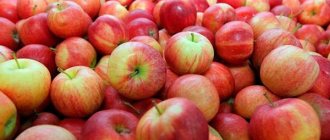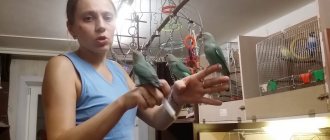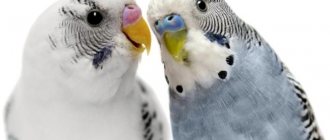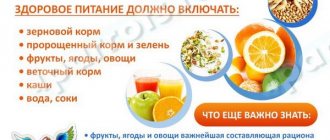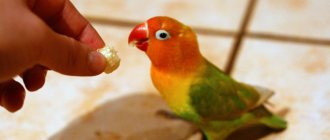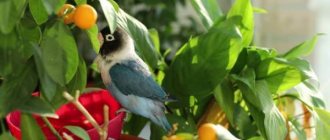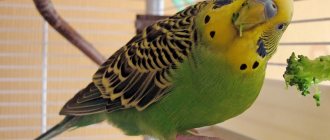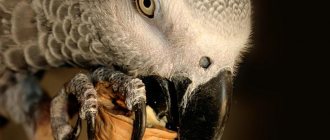One of the reasons for the popularity of budgies is the birds’ unpretentiousness in terms of nutrition. Unlike cockatoos, macaws or African grays, your pet does not require premium food or any specific additives. Nevertheless, the bird's diet should be varied, which in addition to grain food should include fruits, vegetables and cereals.
What kind of cereal can you give?
Porridge for budgies is given at any age. Ornithologists recommend including them in the diet from birth. With the appearance of the young, the female actually prepares the porridge herself in the crop, grinding the grain feed. If there are a lot of chicks and the parents do not physically have time to feed them, then the breeder uses a syringe with the mixture.
You cannot feed parrots grains alone . Not only will the body not receive enough of the necessary nutrients, but also problems with the gastrointestinal tract will appear, where constipation is only a small part of the associated problems.
Porridges are a source of vitamins and minerals. With regular consumption, immunity increases, which reduces the risk of infectious and other diseases. Adults are given porridge every other day. The minimum frequency is a couple of times a week.
Buckwheat
One of the remarkable qualities of buckwheat, not related to the nutritional part, is its unpretentiousness in cultivation.
To increase productivity, it is not treated with chemicals, which cannot be said about other crops. Considering that the parrot’s body is extremely sensitive to fertilizers and other toxins, this is a significant plus.
Boiled buckwheat is also attractive for its composition , which, in addition to 18 amino acids, includes: B vitamins, fiber, folic acid, potassium, magnesium, calcium and iron with zinc. Despite the decent level of calorie content (300 kcal per 100 grams), buckwheat will be useful for obesity, which is not uncommon in pets. It has a positive effect on the gastrointestinal tract, correcting its work in the right direction.
Buckwheat is one of the best natural detoxifiers. The product relatively quickly cleanses the body of carcinogens and toxins.
Oatmeal
Porridge is especially useful for the gastrointestinal tract. One of the key properties of oatmeal is mucosal protection. It envelops it, and fiber promotes intestinal motility. Just like buckwheat, oatmeal is a natural detoxin, although this property is less pronounced.
Oats are rich in vitamins and microelements that are beneficial for the budgie’s body: phosphorus, silicon, group B, iodine, cobalt and potassium. contained in oatmeal has a positive effect on liver function . Experts often recommend porridge for various stomach pathologies.
The calorie content of the product is slightly higher than that of buckwheat - 345 kcal per 100 g, but oatmeal also helps with obesity in birds.
Rice
Rice porridge contains a large amount of complex carbohydrates, and this is a good source of energy. Considering the activity of budgerigars, the latter is especially necessary for them. Porridge has less absorbent properties compared to oatmeal and buckwheat, but still helps to partially remove waste and toxins.
The product contains vitamins E, PP and B, as well as microelements useful for birds: iron, phosphorus, zinc, manganese and calcium with potassium . Minerals have a beneficial effect on the animal’s gastrointestinal tract, and at the same time improve the quality of the plumage.
Unlike buckwheat and oatmeal, rice is a low-calorie product - 130 kcal per 100 g. This is an ideal supplement for birds suffering from obesity.
Do you give your parrot vitamins?
Not really
What is better not to give
Small exotic birds and budgies in particular are not recommended for gluten. This is gluten, which can be dangerous for the animal. It is poorly digested and often gets stuck in the crop.
High Gluten Crops:
- wheat;
- rye;
- spelt;
- barley, including pearl barley;
- couscous;
- bulgur
Opinions in scientific communities about the benefits and harms of gluten are divided. Some say that it is necessary for birds, while others consider it harmful. Given the variety of cereals with low gluten content, it is more advisable to opt for gluten-free products.
Porridge for budgies: buckwheat and rice - can you give it?
To enrich the diet of parrots, many owners use porridge.
They are usually prepared by boiling, but steaming cereals is also allowed. For steaming, use a thermos, into which you pour the cereal and pour boiling water over it. Steam the cereal in this manner for several hours. Regardless of the cooking method, sugar, salt, milk and other additives for human taste should not be added to the porridge. You can improve the taste by flavoring the dish with honey; for one tablespoon of porridge, take half a teaspoon of any honey. The richness of the porridge depends on your pet's preferences. If your parrot likes porridge in the form of jelly, then add more liquid when cooking. If he pecks at the crumbly porridge with great pleasure, then cook it until the liquid has completely evaporated.
How to cook it correctly - recipe
Before cooking the cereal, rinse thoroughly with running water. Professional ornithologist breeders recommend steaming grains in a thermos or a simple thermal mug . That is, add cereal, pour boiling water over it, close the lid tightly and put in a warm place for a couple of hours.
Afterwards the water is drained and the porridge is allowed to cool slightly. To quickly reduce the temperature, the composition can be washed with water. To preserve maximum nutrients, the cereal is soaked in cold water for 12-14 hours. The liquid must be filtered. It is better not to use ordinary running water.
You cannot add salt, sugar, oils and seasonings when preparing porridge . All this can cause serious harm to the animal’s gastrointestinal tract.
As for portions, the norm for budgies is about 1-1.5 teaspoons. The product must be heated, but not hot, otherwise the bird will burn its crop. A cold mixture is harder to digest.
Prohibited Products
A balanced diet is an important condition for a full life for a parrot. Owners strive to feed their pet tasty and satisfying, but sometimes they include prohibited foods in the diet:
- Spices and seasonings provoke severe damage to the digestive system, including the death of the bird.
- Milk and cheese. The parrot's body does not produce enzymes to digest dairy products, so the food simply rots.
- Fungi cause kidney failure in poultry.
- Salt. Parrots happily eat salty grains, but in large doses, salt is a deadly poison.
- Chocolate. Feeding cocoa and sugar has a stimulating effect on the bird's nervous system.
The diet of budgies can be varied without involving prohibited foods. Birds are very fond of nuts, fruits and honey sticks.
General cooking rules
Porridges are a rich source of microelements and nutrients. They have a beneficial effect on digestive processes and normalize metabolism. Porridge for parrots can only be cooked (!) in water without seasonings, oil or salt. There are no exceptions to this rule. Porridge can be offered to parrots 2-3 times a week; it is not worth it more often. Cereals have high energy value and are quite high in calories. The bird will quickly gain weight and become lazy and apathetic. No matter how much a parrot loves porridge, it will never replace grain. Birds can be fed exclusively with cereals for 1-2 days if the main food has run out. Porridge is also used to feed chicks and sick birds that do not have the strength to husk grains.
Before cooking, the cereal is washed under running water. Porridge can be simple or complex (mixed from several types of cereals). Cooking time and volume of water depend on the specific grain. Some birds like crumbly, half-cooked porridge, while others like sticky porridge. The latter option requires more water. Until the owner understands the pet’s taste preferences, he will have to cook different porridges.
Parrots will benefit from:
• rolled oats (without dried fruits and other additives!);
• peas and beans (before cooking they are soaked for 10-12 hours);
Cereals that do not require cooking:
They can be steamed in a thermos or thermal mug. Simply pour the cereal into a container, pour boiling water over it and leave for several hours. Ready porridge should not be stored in the refrigerator for more than 48 hours. Before serving, it is heated in the microwave and then cooled to a lukewarm state so that the parrot does not get burned. The serving size for one bird should not exceed two teaspoons. The porridge is served in a separate bowl or placed on a saucer. It can be sprinkled with grated fruits/vegetables or a pinch of food.
Basic diet of budgerigars
It is known that the basis of a feathered pet’s diet is grain. However, it is important to diversify it with vegetables, fruits, and herbs. Do not forget that the “wavy”, like any other living creature, needs vitamins and minerals for normal life.
Grain feed
When purchasing a parrot, you should ask the breeder what kind of grain feed its parents ate. If the purchase was made at a pet store, it is enough to consult with a specialist to purchase a really good and nutritious product. It is important to consider that its main components may be:
When choosing a feed mixture, you should pay attention to its expiration date. If it has expired, the food will be of poor quality and may negatively affect the health of the bird.
Sprouted feed
It is a known fact that sprouted grains saturate the bird’s body with energy. They are enriched with vitamins, minerals, and fiber. It is important to enrich your bird’s diet with such food in winter. It is best to germinate grains of crops such as:
The shelf life of sprouted feed is only two days. Storage location: refrigerator. For this reason, you should not prepare large quantities of grains. For germination, you will need a shallow dish in which they will be placed, wrapped in gauze. In order for the grains to germinate, they must be constantly moistened.
Forbidden fruits in the “wavy” diet
Considering the fact that there are different foods in the diet of a budgerigar, some of them are strictly prohibited. These include:
Many people are sure that the twigs that birds use to grind down their beaks can be replaced with nuts. In fact, this is a rather fatty product, and therefore it must be used in minimal quantities. A properly organized diet and care for pets will provide them with the conditions necessary for a normal existence next to a person.
Source
General rules for creating menus
Regardless of whether ready-made food is purchased for birds, it is necessary to follow the main rules of the diet for a domestic budgie. The menu for an adult pet should include:
Corn.
This product is considered the main product in the poultry menu. You are supposed to give two teaspoons daily, but for some pets this amount is not enough. You can increase the portion.
The grain must always be in the feeder.
Sprouted grains and legumes.
In this form, the products are absorbed better and provide a complete supply of minerals and vitamins. The amount of sprouted feed is determined by the age of the bird. The maximum dose is 2 teaspoons every seven to ten days. It is intended for parrots before their first molt. Then these foods should be given less often, as they activate the synthesis of the sex hormone. Various types of grains can be used in sprouting.
It is prohibited to use flax and hemp seeds for germination.
Mineral supplements.
This food is necessary to maintain the normal state of the skeletal system and feathers. In addition, such supplements activate digestive processes. Mineral mixtures are available in pet stores, but you can prepare them yourself. The composition includes: charcoal and egg shells in equal quantities, chalk, divided into pieces about 3 mm in size, and shell rock. The finished products offered in pet stores contain cedar nut shells, crushed oyster shells, sandstone, fractions of corals, and sea shells. Birds during molting need to add a little sulfur to this composition. Mineral supplements are poured into a special container. They should be in the pet's cage at all times. Supplements need to be replaced weekly.
Branch food
In order for you to have healthy, active and beautiful budgies, care and feeding must be correct. This means that their diet must contain twig food in addition to grain mixtures, fresh fruits and vegetables. Many bird owners do not suspect that twigs are needed for complete nutrition, and not just for beak care. Through twig food, the parrot receives healthy fiber and microelements.
What trees can you give a parrot? Among those common in Russia are the branches of birch, alder, hazel, cherry, willow, elderberry, aspen, linden, maple, apple, and rowan. They must first be disinfected - scalded with boiling water. Remember that you only need to collect branches away from roads and highways!
Branch food can be offered not only in summer, but also in winter. To do this, cut branches need to be placed in water until the buds swell. Next, you should rinse and scald them with boiling water.
The importance of twigs cannot be underestimated, because in addition to their nutritional value, a parrot can use them as exciting fun, an activity for its beak and paws.
Porridge for parrots is also very healthy. This is not only a source of many microelements, but also a means that will help birds normalize their metabolism if it is disturbed. Cook porridge only in water, without adding sugar or salt.
You can cook complex mixtures consisting of several cereals, as well as mono-porridge for budgies from buckwheat, oatmeal, and brown rice. You can add legumes, as well as grated fruits or vegetables to the porridge. The finished cereal can be cooked viscous or crumbly. In this case, listen to the food tastes of your pet.
You can store the cooked porridge in the refrigerator for no more than 2 days.
Can parrots eat porridge?
Regular consumption of cereal dishes by poultry has a good effect on their health. The main benefit is the intake of vitamin B complex into the body. Its deficiency can cause serious diseases. In addition to vitamins, porridges are rich in amino acids and proteins. They improve the functioning of the digestive and other systems of the body. Newborn parrots are fed liquid formulas. They are prepared from semolina or wheat cereal. Crushed eggshells are added to them. Small chicks are fed from a syringe.
Storing ready-made cereals
The finished dish can be stored in the refrigerator or freezer. Before feeding, remove the required portion from the chamber and defrost it. If “fillers” are added to porridge, they do so after defrosting, that is, the porridge itself is frozen, and not fruits, herbs or vegetables. If you defrost porridge in the microwave, it will lose its crispness and become sticky. When feeding, the porridge should be at room temperature or slightly warm. It is prohibited to feed your parrot cold or hot cereals.
